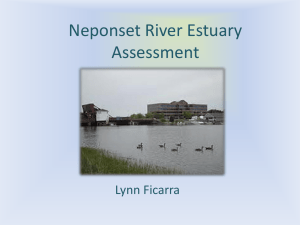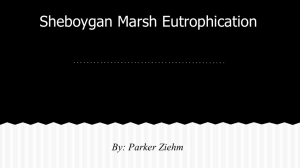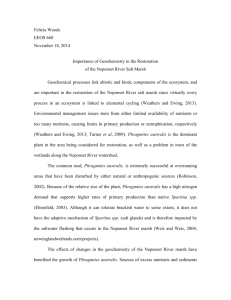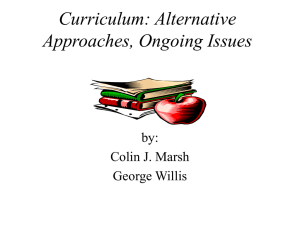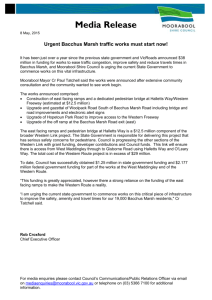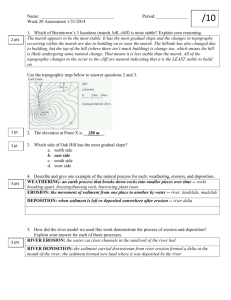Salt marsh plant Neponset report Hensel - BIOEEOS660
advertisement
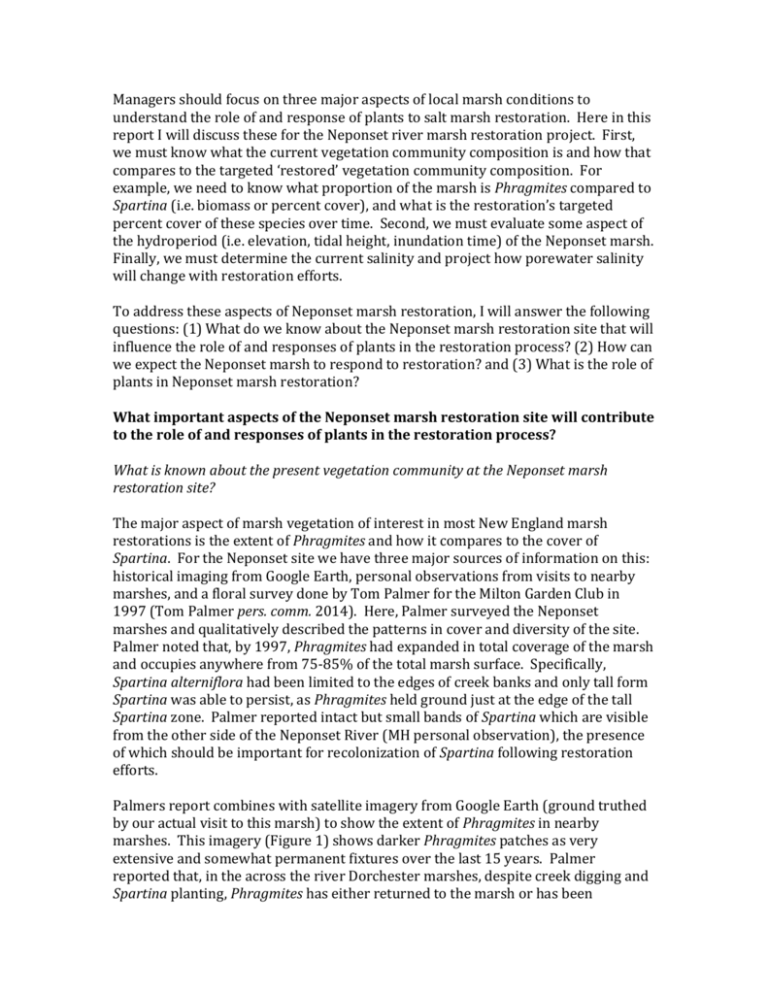
Managers should focus on three major aspects of local marsh conditions to understand the role of and response of plants to salt marsh restoration. Here in this report I will discuss these for the Neponset river marsh restoration project. First, we must know what the current vegetation community composition is and how that compares to the targeted ‘restored’ vegetation community composition. For example, we need to know what proportion of the marsh is Phragmites compared to Spartina (i.e. biomass or percent cover), and what is the restoration’s targeted percent cover of these species over time. Second, we must evaluate some aspect of the hydroperiod (i.e. elevation, tidal height, inundation time) of the Neponset marsh. Finally, we must determine the current salinity and project how porewater salinity will change with restoration efforts. To address these aspects of Neponset marsh restoration, I will answer the following questions: (1) What do we know about the Neponset marsh restoration site that will influence the role of and responses of plants in the restoration process? (2) How can we expect the Neponset marsh to respond to restoration? and (3) What is the role of plants in Neponset marsh restoration? What important aspects of the Neponset marsh restoration site will contribute to the role of and responses of plants in the restoration process? What is known about the present vegetation community at the Neponset marsh restoration site? The major aspect of marsh vegetation of interest in most New England marsh restorations is the extent of Phragmites and how it compares to the cover of Spartina. For the Neponset site we have three major sources of information on this: historical imaging from Google Earth, personal observations from visits to nearby marshes, and a floral survey done by Tom Palmer for the Milton Garden Club in 1997 (Tom Palmer pers. comm. 2014). Here, Palmer surveyed the Neponset marshes and qualitatively described the patterns in cover and diversity of the site. Palmer noted that, by 1997, Phragmites had expanded in total coverage of the marsh and occupies anywhere from 75-85% of the total marsh surface. Specifically, Spartina alterniflora had been limited to the edges of creek banks and only tall form Spartina was able to persist, as Phragmites held ground just at the edge of the tall Spartina zone. Palmer reported intact but small bands of Spartina which are visible from the other side of the Neponset River (MH personal observation), the presence of which should be important for recolonization of Spartina following restoration efforts. Palmers report combines with satellite imagery from Google Earth (ground truthed by our actual visit to this marsh) to show the extent of Phragmites in nearby marshes. This imagery (Figure 1) shows darker Phragmites patches as very extensive and somewhat permanent fixtures over the last 15 years. Palmer reported that, in the across the river Dorchester marshes, despite creek digging and Spartina planting, Phragmites has either returned to the marsh or has been restricted to large patches throughout the marsh (see picture). Lastly, personal observations and Palmer’s report indicates that much native marsh plant diversity is present in the system but it may be restricted to small zones throughout the area. What aspects of the hydroperiod are known for the Neponset marsh? We can use NOAA bouy data to estimate the tidal height for the Neponset marsh in the absence of on the ground tidal topographic maps. NOAA data indicates that the normal maximum tidal height of the Neponset in this area is ~9 -11 feet. This tidal elevation is similar to many other restoration marshes throughout New England that lie near openings to a larger oceanic body of water (Warren et al. 2002, Smith et al. 2009). Local inundation time should be calculated in the marsh to determine if the tidal elevation varies throughout the marsh, as local variation in elevation could explain the patchy stands of Phragmites or the narrow band of Spartina in the Neponset marsh. What is the salinity of the Neponset river at this site? There is no porewater salinity data for the Neponset marsh but a paper from Gardner et al. (2005) measured salinity at different locations throughout the Neponset. Salinities, which vary annually depending on precipitation and time of year, reached around 30-32 ppt in August 2002 in the section of the Neponset nearest to our restoration site. Using information from other studies that indicate a ppt of 25 is what begins to kill Phragmites (Warren et al. 2002), we can assume that the porewater salinity of the Neponset marsh is below this. However, because channel salinities are in the 30-32 ppt range, porewater salinities will likely increase with the expansion of marsh creeks from restoration. How can we expect plants in the Neponset marsh to respond to restoration efforts? Salinity response and Phragmites die back There are a number of restoration projects that have similar tidal heights and salinity levels to that of the Neponset system (Burdick and Dionne 1996, Warren et al. 2002, Buchsbaum et al. 2006, Smith et al. 2009). As mentioned, since salinities in the Neponset near our site have been found to be around 30 ppt (Gardner et al. 2005), restoration of creek flow into the marsh should increase marsh porewater salinity. The timing of this salinity restoration depends on tidal volume and precipitation. In similar systems, salinity levels returned to that of non-restored reference sites in 1-5 years (Warren et al. 2002). In that study, shallower sediments recovered their porewater salinities faster than deeper sediments but once porewater salinities reached 25 ppt, Phragmites will start to die back. Smith et al. (2009) found that the die back of Phragmites varied not only with the initial salinity but also the ability for higher salinities to be maintained. In this study, precipitation varied and thus slowed salinity recovery to 3-5 years. In both studies however, Phragmites cover decreased and Spartina cover increased, responses we can expect in the Neponset marsh site in relation to increases in porewater salinity. We can expect this in Neponset because of the already oceanic levels of salinity (i.e. no tidal flow restriction) and the remnant population of Spartina which can serve as a source for eventual expansion. Changes in plant community distribution throughout the marsh Because of the presence of the thin band of Spartina near creek banks at our site, it is likely that this will provide the nucleus of recovery. Like in Smith et al. (2009) (Figure 2), as restoration progresses and porewater salinities increase, Phragmites will likely move back into the higher marsh. Over time, we would expect the remnant Spartina to recolonize the area abandoned by Phragmites. Like in the Dorchester Marsh across the river from our site, we should expect patches of Phragmites to be a relatively permanent fixture post-restoration due to elevation heterogeneity and persistence of Phragmites. Nutrients, development, and Neponset restoration Restoring a marsh from Phragmites dominated to Spartina dominated in the Neponset will also require some caution regarding nitrogen loading in the system. Research in New England has shown a high correlation with the amount of developed coast, nitrogen availability, and the presence of Phragmites (Bertness et al. 2002, Silliman and Bertness 2004). Returning salinity levels to 26ppt in the marsh may not be enough to reduce Phragmites stands because our marsh site is likely heavily impacted. Besides the large interstate that goes through our system, the whole Neponset River is surrounded by development. Specific data on this is lacking but it is possible that just changing salinities may not yield the desired plant community. What is the role of plants in Neponset restoration? First and foremost, the role of plants in the overall restoration process is to use the plant community as a gauge for the success of the restoration. The ultimate goal of this and most restorations is to return the plant community to a Spartina dominated marsh with a diveristy of high marsh species (e.g. Spartina patens, Iva frutescens, Juncus gerardii). In this light, an important role of plants in the Neponset restoration is to provide a source population for clonal or sexual recovery and to facilitate the colonization of other marsh area. Recovery of marshes to other stressors has been shown to be dependent on remnant patch size and positive interactions (Angelini and Silliman 2012). Another role of plants in the Neponset restoration is to increase species richness and ecosystem functioning. Once the restoration takes place and plant communities begin to shift from Phragmites to Spartina, we should see the marsh food web also recover(Roman et al. 2002, Buchsbaum et al. 2006). Healthy Spartina marsh supports a number of resident and transient marsh species that Phragmites marshes do not (Roman et al. 2002). Because the Neponset marsh has been dominated by Phragmites for so long, the food web may have to be replenished from outside source populations. A number of intact salt marshes are located in the vicinity of the Neponset marsh and could provide larvae for recolonization. Additionally, the Spartina food web that is present in the remnant band along the creek banks may provide a source for the rest of the marsh. Observations at the Dorchester marsh across from our site indicated low populations of fiddler crabs and Littorina snails, which would be expected to colonize new Spartina as it expands. Basically, as Spartina expands, the marsh food web and marsh ecosystem functions such as increased sedimentation and carbon sequestration will recover as well. Figure 1. Google earth images of Neponset marsh restoration site and surrounding areas from 2003 (top) and 2013 (bottom). Dark or brown patches are patches of Phragmites confirmed by ground truthing Figure 2 (adapted from Smith et al 2009). In certain cases, Phragmites total cover may not change on the whole marsh scale but it can be pushed back from the creek bank, as in the transects shown in (a). The Neponset river site will likely undergo a similar shift in plant community because of the thin band of Spartina currently on the creek banks, providing the nucleus for recovery Angelini, C., and B. R. Silliman. 2012. Patch size-dependent community recovery after massive disturbance. Ecology 93:101–10. Bertness, M. D., P. J. Ewanchuk, and B. R. Silliman. 2002. Anthropogenic modification of New England salt marsh landscapes. Proceedings of the National Academy of Sciences of the United States of America 99:1395–8. Buchsbaum, R., J. Catena, E. Hutchins, and M. James-Pirri. 2006. Changes in salt marsh vegetation, Phragmites australis, and nekton in response to increased tidal flushing in a New England salt marsh. Wetlands 26:544–557. Burdick, D., and M. Dionne. 1996. Ecological responses to tidal restorations of two northern New England salt marshes. Wetlands Ecology and … 4:129–144. Gardner, G. B., R. F. Chen, and A. Berry. 2005. High-resolution measurements of chromophoric dissolved organic matter (CDOM) in the Neponset River Estuary, Boston Harbor, MA. Marine Chemistry 96:137–154. Roman, C. T., K. B. Raposa, S. C. Adamowicz, M.-J. James-Pirri, and J. G. Catena. 2002. Quantifying Vegetation and Nekton Response to Tidal Restoration of a New England Salt Marsh. Restoration Ecology 10:450–460. Silliman, B., and M. Bertness. 2004. Shoreline development drives invasion of Phragmites australis and the loss of plant diversity on New England salt marshes. Conservation Biology:1424–1434. Smith, S. M., C. T. Roman, M.-J. James-Pirri, K. Chapman, J. Portnoy, and E. Gwilliam. 2009. Responses of Plant Communities to Incremental Hydrologic Restoration of a Tide-Restricted Salt Marsh in Southern New England (Massachusetts, U.S.A.). Restoration Ecology 17:606–618. Warren, R. S., P. E. Fell, R. Rozsa, a. H. Brawley, A. C. Orsted, E. T. Olson, V. Swamy, and W. a. Niering. 2002. Salt Marsh Restoration in Connecticut: 20 Years of Science and Management. Restoration Ecology 10:497–513.

